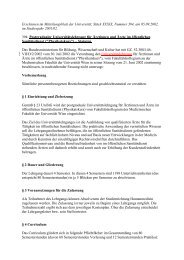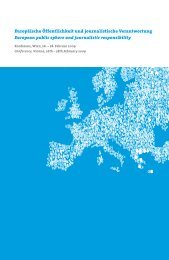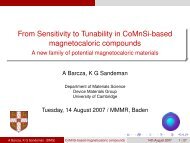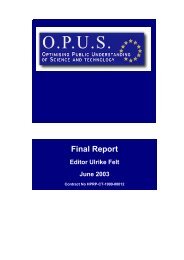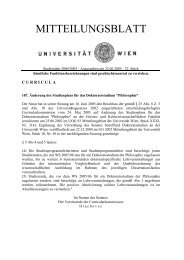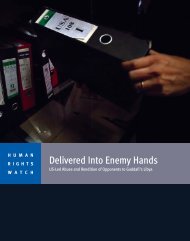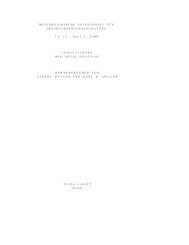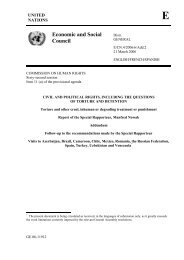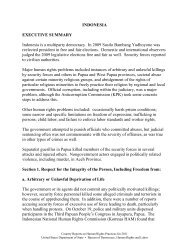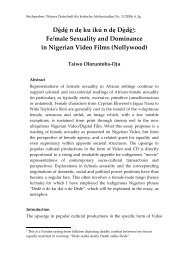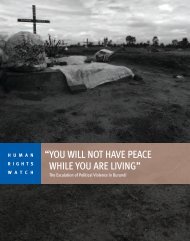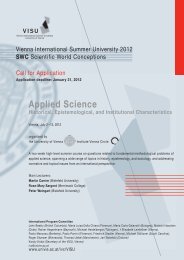(Stand: 25. Juli 2007) ANDERSON, Michael Alan ... - Universität Wien
(Stand: 25. Juli 2007) ANDERSON, Michael Alan ... - Universität Wien
(Stand: 25. Juli 2007) ANDERSON, Michael Alan ... - Universität Wien
You also want an ePaper? Increase the reach of your titles
YUMPU automatically turns print PDFs into web optimized ePapers that Google loves.
MEDIEVAL & RENAISSANCE MUSIC CONFERENCE <strong>2007</strong> – WIEN, 7.-11. AUGUST ABSTRACTS<br />
Doppelkanons in Anticos Druck Motetti novi e chanzoni franciose a quatro sopra doi (RISM<br />
1520 3 ), den „freien“ Pol durch den allgemeinen Hinweis auf die Fülle von „mille belle, e<br />
leggiadri inventioni“ in den Werken Adrian Willaerts. Ausgehend von Anticos Druck<br />
soll das Bedeutungsspektrum von Zarlinos Begriff dargestellt und mit Beispielen<br />
illustriert werden.<br />
� �<br />
JENKINS, Chadwick (Columbia University)<br />
“Est modus in rebus”: Horace, Aristotle, and the Late-Renaissance Theory of the<br />
Modes<br />
Samstag/Saturday, 11.8., 11.45 Uhr, KuGe, SR 3<br />
Late-Renaissance music-theoretical treatises are rife with citations from authority ranging<br />
from philosophy to history to poetry. Therefore, it is not surprising that Horace should be<br />
prominently featured in the writings of two of the most important music theorists of the<br />
era, Gioseffo Zarlino and Giovanni Maria Artusi. However, two specific citations from<br />
Horace (one from the first Satire and the other from the Ars Poetica), when combined<br />
with Aristotelian hylomorphic theory, play a particularly prominent role in Zarlino and<br />
Artusi’s understanding of a notoriously fractious music-theoretical concept: the modes.<br />
The musical modes, for these writers, involve limits beyond which a composer must<br />
not go. This Horatian insight regarding the proper limits of any given entity is conjoined<br />
with Aristotelian hylomorphism in that the modes are also regarded as substantial forms.<br />
According to Aristotle, the substantial form defines what a thing is, its quiddity. Although<br />
a range of accidental forms or particular individual entities may exist, they must<br />
all be subsumed beneath a given substantial form. Thus this concept also serves as a definitional<br />
limit. An understanding of the combination of these Horatian and Aristotelian<br />
concerns clarifies what these theorists mean by defining mode “as form“.<br />
The warning that opens Horace’s Ars Poetica (that combining things improperly<br />
gives rise to the monstrous) thus informs Artusi’s critical concern for modal unity. To<br />
compose a work that mixes substantial forms is to give birth to a deviant, formless entity<br />
that cannot function properly as music. This is one of Artusi’s primary reasons for rejecting<br />
Monteverdi’s music.<br />
This investigation of the use of Horace’s poetry tempered by Aristotelian metaphysics<br />
clarifies an important function that ancient Latin poetry played within Late-<br />
Renaissance understandings of music. It demonstrates that such poetic citations served as<br />
an integral part of the theoretical enterprise.<br />
� �<br />
- 45 -




